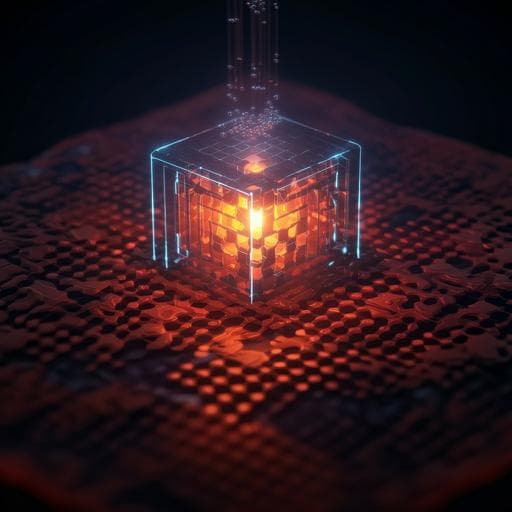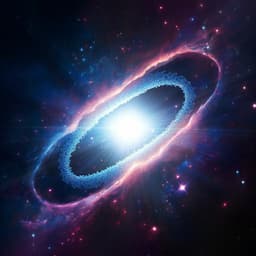
Physics
Spin properties and optical transitions of the CO2 defect in silicon for quantum technology applications
P. Udvarhelyi
This research by P. Udvarhelyi delves into the intriguing CO2 defect in silicon, revealing its potential as a single-photon source and a promising platform for quantum computing, thanks to groundbreaking insights on spin interactions and optical transitions.
~3 min • Beginner • English
Introduction
Literature Review
The paper situates the C-centre (C_O defect complex in silicon) among other silicon quantum emitters: G- and T-centres emit in the telecommunication O-band, W-centre near the short-wavelength edge of O-band, and Er3+ in the C-band. The C-centre’s ZPL lies in the L-band, advantageous for fibre transmission. Reported radiative lifetimes and enhancement strategies for other centres are cited: Er3+ shows ~1–2 ms lifetime that can be reduced 10× in waveguides and up to ~70× enhanced in resonators; G-centre ensemble lifetime 5.9 ns with ~40× PL enhancement via metasurface; T-centre has 940 ns excitonic lifetime with up to ~58× Purcell enhancement. Prior EPR data for the Si-G15 centre provide 13C hyperfine parameters used for comparison. The work references prior PL observations of local vibrational modes (LVMs) and magneto-PL features, and prior demonstrations of ODMR and long coherence in other silicon defects (T-centre, Er3+), motivating exploration of the C-centre for quantum technologies.
Methodology
First-principles electronic structure calculations were performed using spin-polarised hybrid density functional theory (DFT) with the HSE06 functional in VASP. The defect was modeled in a 512-atom silicon supercell with Γ-point Brillouin zone sampling and projector augmented wave (PAW) pseudopotentials for core electrons. The CO defect complex consists of neighbouring carbon (C–Si split interstitial) and oxygen (O–Si split interstitial) defects. Electronic states were analysed in the C1h point group; excited states were treated within an all-electron self-consistent field (ASCF) approach for excitations. Finite-size electrostatic corrections consistent with charge transition level calculations were applied to the zero-phonon line (ZPL) due to excitonic character. Validation was carried out with G0W0 plus Bethe–Salpeter equation (G0W0+BSE) calculations in a 216-atom supercell using HSE06-relaxed ground-state geometries; vertical excitation energies and singlet–triplet splittings were compared between methods. Spin properties were evaluated by computing the dipolar spin–spin zero-field splitting (ZFS) parameters (D, E) for the triplet excited state and by constructing and evaluating the spin–orbit coupling (SOC) Hamiltonian. SOC matrix elements were obtained from DFT on an ordered basis of one-particle spin–orbitals, enabling extraction of A_z and transverse A_⊥ couplings and analysis of selection rules between singlet and triplet manifolds. Hyperfine tensors were calculated for 13C, 17O, and 29Si nuclei around the defect to compare neutral triplet and positive doublet states and to identify candidate nuclear registers. Optical properties were simulated using the Franck–Condon approximation: phonon spectra and partial Huang–Rhys factors were computed to generate PL sidebands and Debye–Waller factors, and radiative transition dipoles were estimated for phosphorescence branches, including intersystem crossing (ISC) paths mediated by SOC. Proposed quantum control protocols were analysed using level anti-crossing (LAC) conditions, Landau–Zener transitions leveraging transverse hyperfine terms (Axx, Ayy), and microwave control to map electron spin coherence to nuclear spin registers and back.
Key Findings
- Electronic structure: A single in-gap state arises from the carbon dangling bond, forming a deep donor level. The calculated (+/0) charge transition level is E_VBM + 408 meV, consistent with DLTS at 360 meV. The ground state is 1A′ with two electrons in the deep defect level; excitation to the CBM yields singlet (1A″) and triplet (3A″) excited states.
- Excitation energetics: The calculated singlet–singlet ZPL is 750 meV (after finite-size correction), smaller than the donor transition energy E_CBM − E_(+/0) = 780 meV, implying a stable neutral emitter. The triplet excited state lies 2.8 meV below the excited singlet, matching the rISC activation energy of ~3.1 meV.
- Many-body validation: G0W0+BSE calculations (216 atoms) agree with HSE06-ASCF within 11 meV for vertical excitation energy and 15 meV for the excited-state singlet–triplet splitting; the exciton wavefunction is dominated by a single Slater determinant, justifying the ASCF approach.
- Spin Hamiltonian and SOC: Triplet ZFS from dipolar spin–spin interaction yields D = −771 MHz and E = 94 MHz. D and E split the ms sublevels into Γ1(−), Γ1(+), Γ2(0). SOC matrix A (meV) elements lead to extracted couplings A_z = −0.275 meV and transverse components A_⊥ ≈ (0.223+0.043i) meV and (0.108−0.043i) meV. SOC renormalises the axial ZFS to D ≈ 5.7 GHz, aligning with ~3 GHz features in magneto-PL, and induces ~1% triplet admixture into the excited singlet (ms = 0).
- Hyperfine interactions: For the positively charged defect at 13C, calculated Axx = 5.9 MHz, Ayy = 5.2 MHz, Azz = 153.9 MHz agree with Si-G15 EPR reports; in the neutral triplet, Axx = 3.1 MHz, Ayy = 2.7 MHz, Azz = 77.2 MHz. Several 29Si positions show transverse hyperfine >10 MHz (NN/NNN) useful for fast LAC-based state transfer; sites with ~1 MHz couplings are suggested for longer coherence quantum registers.
- Optical properties: PL sideband exhibits LVMs at ~63, 70, 134 meV, and a weaker LVM at ~87 meV, matching experimental spectra. Huang–Rhys factor S = 2.1 implies a Debye–Waller factor ~12%. Excitonic excited state is relatively delocalised, consistent with long optical lifetimes. SOC enables spin-selective ISC and phosphorescence: ms = 0 branch has ~1% of the singlet’s ZPL intensity, giving ~1.4 ms radiative lifetime; ms = −1 and +1 branches have weak dipoles (0.004 D and 0.002 D) and >10 ms radiative lifetimes.
- Temperature dependence: The absence of phosphorescence at elevated temperatures is explained by thermally activated rISC that thermalises excited states, reducing ODMR contrast and phosphorescence.
- Telecommunications relevance: The C-centre ZPL lies in the L-band, favourable for fibre transmission compared to G/T (O-band), W (near O-band edge), and Er3+ (C-band).
- Quantum control protocols: A spin-selective ISC polarises the triplet into the bright ms = 0 state enabling ODMR contrast via phosphorescence. Landau–Zener passages at triplet LAC, driven by transverse hyperfine terms, can map electron spin superpositions to nearby nuclear spins and back, enabling long-lived quantum memory. Alternative mapping using weak transverse B-field and resonant microwaves is feasible. After triplet relaxation to the singlet ground state, electron-spin-induced decoherence is removed, enhancing nuclear coherence.
Discussion
The computed electronic structure, excitation energies, and SOC-mediated interactions of the C_O (C-centre) defect in silicon reproduce and rationalise experimental observations (DLTS level, PL sidebands, magneto-PL features, triplet phosphorescence). The excitonic nature of the excited states combined with SOC leads to a stable neutral emitter with accessible singlet and triplet manifolds. SOC enables an efficient, spin-selective ISC pathway that polarises the triplet into ms = 0, explaining observed phosphorescence at cryogenic temperatures and its quenching via rISC at higher temperatures. The substantial SOC-induced ZFS and hyperfine landscape enable coherent spin control, optical detection of magnetic resonance via phosphorescence, and transfer of electron spin coherence to proximal nuclear spins for quantum memory. Given its ZPL in the telecom L-band and compatibility with silicon photonics, the C-centre emerges as a promising single-photon and spin-photon interface defect for quantum communication and sensing at cryogenic temperatures.
Conclusion
The study identifies and characterises the C-centre (C_O defect complex) in silicon as a viable quantum emitter and spin system. First-principles calculations yield a stable neutral emitter with a singlet ground state and closely lying singlet/triplet excitations, SOC-enabled spin-selective ISC, and phosphorescence consistent with experiments. Spin Hamiltonian parameters (ZFS, SOC) and hyperfine couplings support ODMR via phosphorescence and protocols for mapping electron spin coherence to nuclear spins for long-lived quantum memory. The PL spectrum, Huang–Rhys factor, and telecom L-band ZPL make the C-centre attractive for integration with silicon photonics. Future work should pursue in-depth experimental studies of spin dynamics, temperature-dependent ISC/rISC rates, and device-level integration, including cavity or metasurface coupling for Purcell enhancement to brighten PL and phosphorescence.
Limitations
- Computational forces at the G0W0+BSE level are not implemented; validation relied on vertical excitations at HSE06-relaxed geometries rather than fully relaxed excited-state structures.
- Many quantitative results (ZPL, ZFS, SOC, hyperfine) are theory-driven and require systematic experimental verification, including direct ODMR and temperature-dependent phosphorescence measurements.
- The observed reduction of phosphorescence and ODMR contrast at elevated temperatures due to rISC limits room-temperature operation; the presented protocols are mainly feasible at cryogenic temperatures.
- Finite-size and electrostatic corrections were applied to account for excitonic and charge-state effects; residual supercell errors may remain.
- Hyperfine-based quantum memory performance depends on specific nuclear configurations (e.g., 29Si locations and concentrations), implying variability and the need for isotope engineering.
Related Publications
Explore these studies to deepen your understanding of the subject.







